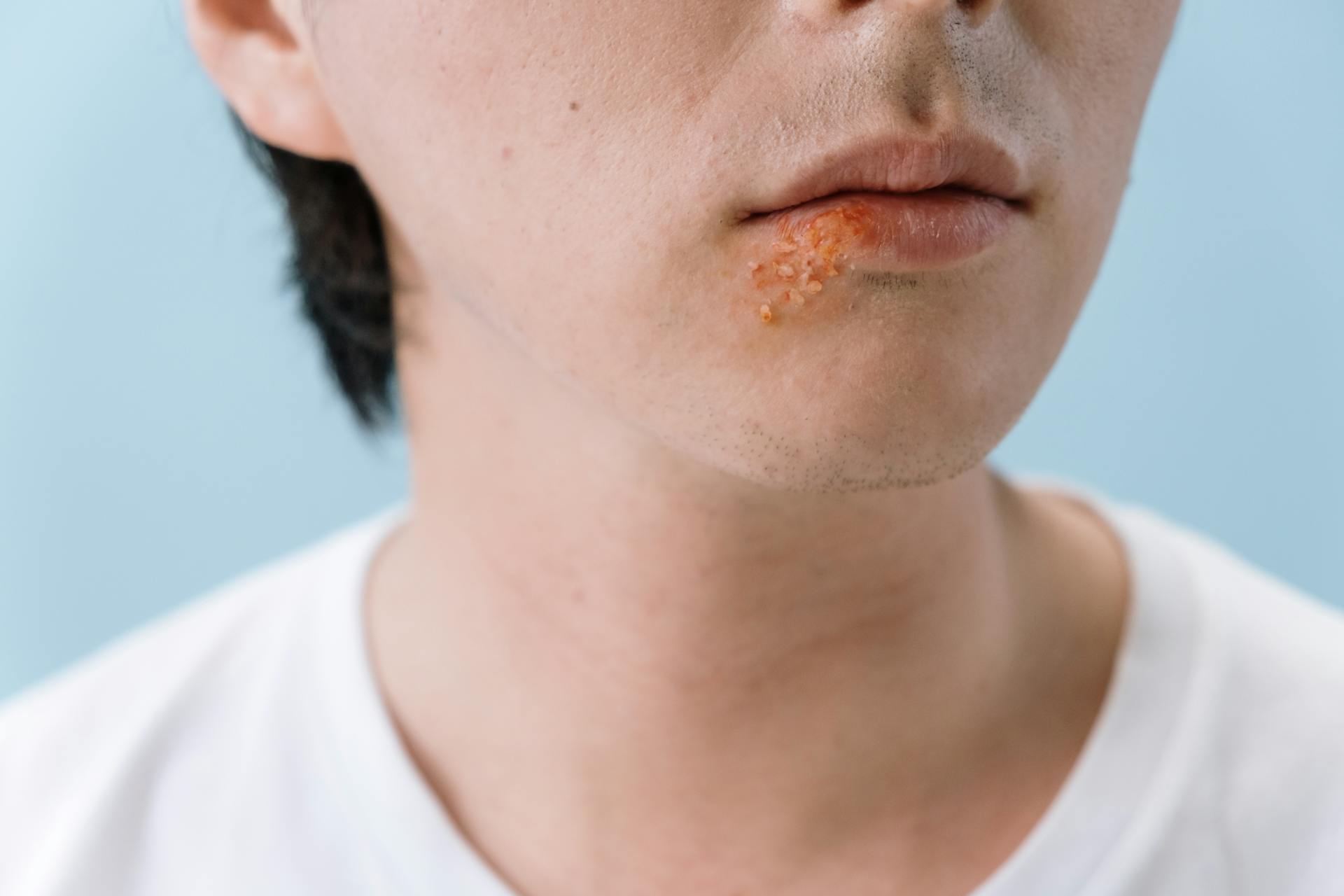
Ringworm in Shih Tzus is a common skin infection that can be frustrating to deal with. It's caused by a fungus called Microsporum canis, which is highly contagious and can spread quickly.
The fungus thrives in warm and humid environments, making Shih Tzus more susceptible to infection. Their thick coats can trap moisture, creating an ideal breeding ground for the fungus.
Shih Tzus are more likely to get ringworm if they come into contact with an infected animal, person, or contaminated object. This can happen through direct contact, such as touching or licking, or indirectly through shared grooming tools or bedding.
Preventing ringworm in Shih Tzus requires attention to hygiene and regular grooming.
What Is Ringworm in Shih Tzu?
Ringworm in Shih Tzu is a fungal infection that gets its name from the ring-like appearance on raised and red skin rashes. Ringworm is not actually a worm, but a type of fungus.
The fungus grows and lives in the outermost layer of skin and in the hair follicles of infected dogs. It can also occasionally grow and live in their nails.
Ringworm is scientifically known as dermatophytes, a collection of pathogenic fungi. In dogs, 70% of ringworm cases are caused by the fungus Microsporum canis and 20% are caused by the fungus Microsporum gypseum.
Puppies, senior dogs, and immunocompromised dogs are more prone to widespread ringworm infections.
Causes and Spread
Ringworm in shih tzus can be spread through direct contact with an infected animal or person. This can happen when your dog comes into contact with an infected animal or person, or when they touch a contaminated object.
The fungal spores responsible for the spread can remain viable for up to 18 months. This means that ringworm can be spread through shedding or breaking of infected hairs, even after the initial infection has cleared up.
Ringworm can also be spread through contaminated objects, such as couches, combs, food bowls, bedding, or carpet. If your dog has been infected, it's essential to clean and disinfect these objects thoroughly to prevent the spread of the fungus.
Dogs often get ringworm from playing outdoors, as some forms of the fungus can live freely in the soil. This is especially true for shih tzus, who love to explore the great outdoors and play in the dirt.
Your dog's immune system may be able to fight off the fungus, or it may turn into a localized or more widespread skin infection. Factors that can influence the severity of the infection include your pet's overall health, the species of fungus, the part of the body affected, and your dog's age.
If your shih tzu has been diagnosed with ringworm, it's a good idea to have your other pets checked by a veterinarian to be safe. This will help prevent the spread of the fungus to other pets in your household.
Symptoms and Diagnosis
Ringworm in Shih Tzus can be identified by circular areas of hair loss throughout the body, which may start to heal in the center as they enlarge, creating a patchy appearance.
These lesions may become inflamed or scabbed, and the affected hair follicles are brittle and break easily, which helps spread the disease throughout your home.
Broaden your view: Shih Tzu No Fur
In some cases, the fungus infects the claws, making them brittle and rough.
Symptoms of ringworm in Shih Tzus include:
- Circular areas of hair loss
- Dry, brittle hair
- Scabby, inflamed skin
- Rough, brittle claws
To diagnose ringworm, veterinarians use an ultraviolet lamp to examine a dog's fur and skin. This is the most trustworthy test, but it takes 10 days to provide findings.
If you suspect your Shih Tzu has ringworm, take them to the clinic immediately since they will require treatment to be cured.
Symptoms
Ringworm can manifest in various ways, and it's essential to be aware of the symptoms to catch the disease early.
Ringworm often appears as patches of hair loss with a crusty coating, but it can also look like a grey, scaly patch of skin, or a bright red sore patch.
In rare cases, ringworm can be asymptomatic, making it harder to detect.
If you notice any of the following signs, contact your vet right away:
- Dry, brittle hair
- Inflamed, red skin rash
- Circular or patchy areas of hair loss
- Scales that look like dandruff
- Scabs or lesions on the skin
- Darkened skin
- Reddened skin
- Inflamed folds of the skin around the claws or nails
- Itchiness
Ringworm typically presents as circular areas of hair loss throughout the body, which may start to heal in the center as they enlarge.

The affected hair follicles are brittle and break easily, which helps spread the disease throughout your home.
In some cases, the fungus infects the claws, making them brittle and rough.
Here are some common symptoms of ringworm in dogs:
- Circular areas of hair loss
- Dry, brittle hair
- Scabby, inflamed skin
- Rough, brittle claws
Can Humans Get?
Can Humans Get Ringworm?
Humans can get Microsporum canis, the same fungus that causes ringworm in dogs. Young children, the elderly, and those with compromised immune systems are at an increased risk of contracting ringworm from dogs.
Anyone can contract ringworm, but it's especially concerning for those with weakened immune systems.
Diagnosing
If you suspect your dog has ringworm, it's essential to take them to the clinic immediately. Your veterinarian may examine your dog's fur and skin using an ultraviolet lamp, which is the most trustworthy test for diagnosing ringworm.
This test takes 10 days to provide findings, so it's crucial to act quickly if you notice any symptoms. The sooner you get your dog examined, the sooner you can start treatment and get them back on the road to recovery.

If your dog is diagnosed with ringworm, it's likely that they'll require treatment to be cured. Your veterinarian will work with you to develop a plan to get your dog feeling better.
Here are some common signs of ringworm in dogs:
- Dry, brittle hair
- Inflamed, red skin rash
- Circular or patchy areas of hair loss
- Scales that look like dandruff
- Scabs or lesions on the skin
- Darkened skin
- Reddened skin
- Inflamed folds of the skin around the claws or nails
- Itchiness
Keep in mind that ringworm can be asymptomatic in some cases, so it's essential to stay vigilant and monitor your dog's health closely.
Treatment and Prevention
Treatment for ringworm in Shih Tzus usually consists of three steps: topical therapy, oral medications, and environmental decontamination.
Topical therapy can be a cream, ointment, or medicated shampoo, and it may take several months to fully eliminate the infection. Your veterinarian may also suggest clipping long-haired dogs to speed up treatment and shaving the hair from affected areas.
Your vet will likely ask you if you have any other pets in the household and may advise that you test and treat them for ringworm, as well, even if they are not currently showing signs of a ringworm infection.
To prevent reinfection of ringworm in dogs, it's essential to fully cleanse the environment of the home and any tools and bedding that the animals regularly come into contact with, and to follow the instructions of your veterinarian.
Here are the most common treatments for ringworm:
- Topical medication
- Anti-fungal oral medication
- Environmental decontamination (such as deep cleaning a carpet to keep the infection from spreading)
Treatment of
Treatment of ringworm in dogs involves a combination of topical and oral medications, as well as environmental decontamination. Your veterinarian will help you choose the best treatment plan based on the severity of the infection.
Topical therapy is usually the first line of treatment, and it can take several months to fully eliminate the infection. Your vet may recommend a cream, ointment, or medicated shampoo to help control the infection, and they might also suggest clipping long-haired dogs to speed up treatment.
Oral medications, such as anti-fungal medications, are often used in conjunction with topical therapy to help fight the infection. They need to be administered for a minimum of six weeks, but in some cases could take months to take full effect.

Environmental decontamination is also crucial in preventing the spread of ringworm. Your vet may recommend deep cleaning carpets and other surfaces to get rid of fungal spores.
Here are the most common treatments for ringworm:
- Topical medication
- Anti-fungal oral medication
- Environmental decontamination (such as deep cleaning a carpet to keep the infection from spreading)
It's essential to follow your vet's treatment plan and continue to treat your dog for the prescribed period of time, even if the clinical signs go away. Just because the symptoms disappear doesn't mean that your dog is no longer contagious, and your vet will likely want to retest your dog for ringworm before giving you the "all clear."
Preventing the Spread of
Ringworm is spread by direct contact with an infected animal or through a contaminated substance. If surfaces are not cleaned, ringworm can linger on them or become trapped in the fibers of carpets, curtains, and linens.
To eliminate the spores, soft furniture and carpets should be vacuumed thoroughly and regularly, or steam cleaned. Disinfectants should be used to clean any other things. Consult your veterinarian about which disinfectants are effective.
Ringworm spores are tenacious and may survive in the environment for a long time, so confine your affected dog to a single room while you treat them.
If you heal your dog but do not eliminate the virus from your home, your dog may become sick again. This is why it's essential to fully cleanse the environment of the home and any tools and bedding that the animals regularly come into contact with.
Here are some steps to take to prevent the spread of ringworm:
- Vacuum soft furniture and carpets thoroughly and regularly, or steam clean them.
- Use disinfectants to clean any hard surfaces.
- Confine your affected dog to a single room while you treat them.
- Have your other pets checked by a veterinarian to be safe.
- Alert any fellow dog owners and dog-walking buddies that your dog has been infected and is being treated.
Frequently Asked Questions
Can ringworm in dogs heal on its own?
Most ringworm infections in dogs resolve on their own, but treatment is often recommended to shorten the duration and prevent spread. Treatment typically involves topical therapy or oral medication.
What could be mistaken for ringworm in dogs?
Dogs with bacterial skin infections, skin yeast infections, or allergies may exhibit similar symptoms to ringworm, making diagnosis challenging. If you suspect ringworm in your dog, consult a veterinarian for an accurate diagnosis and effective treatment options.
What infection looks like ringworm in dogs?
Folliculitis is a skin infection in dogs that can resemble ringworm, caused by bacteria, mites, or fungi like ringworm. It's essential to consult a veterinarian for proper diagnosis and treatment to prevent further complications.
Can I put human antifungal cream on my dog?
Use human antifungal cream on your dog only under veterinary guidance, as a small portion applied to a single skin lesion is generally safe. Consult your local veterinarian before using any topical medication on your dog.
Sources
- https://www.brownsbridgeah.com/site/blog/2022/05/18/ringworm-looks-like-on-dog
- https://www.summervilleanimalhospital.org/site/blog/2022/05/30/dog-ringworm
- https://www.vscot.com/site/blog/2020/12/03/diagnose-treat-fungal-infections-in-dogs
- https://www.cinderrockvetclinic.com/site/blog/2022/07/15/dog-ringworm
- https://www.akc.org/expert-advice/health/ringworm-in-dogs/
Featured Images: pexels.com


